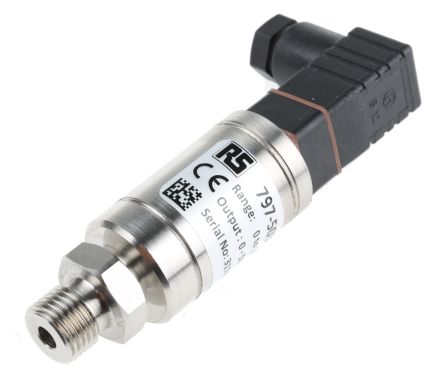A pressure transducer is a piece of instrumentation that converts pressure into an electrical output signal. The electrical signal can be digital or analog and can be used by other devices such as alarms, controllers, etc. Pressure transducers are used in a wide variety of residential and commercial applications such as pumps, vehicles, air conditioners, aircraft and other applications. What’s more about the pressure transducer?
How does a pressure transducer work?
Converting the pressure into an electrical signal in the pressure transducer is done by changing the physical shape of the pressure gauges that are connected to the diaphragm of the transducer and then connected to the Wheatstone bridge. The pressure applied to the pressure transducer causes a deflection in the diaphragm, which applies a certain pressure to the gauge. In fact, the strain (displacement) of the diaphragm proportional to the applied pressure creates a change in electrical resistance. In this way, the pressure will be converted into its analog equivalent and will be understandable to the user.
A pressure transducer is made of a pressure-sensitive element such as a fixed surface diaphragm. The pressure exerted by the fluid causes the diaphragm to deflect. Also, this transducer consists of a transmission element that converts the deviation sensed by the diaphragm into an electrical signal. This signal increases or decreases according to pressure changes. Therefore, it is important to calibrate the device to ensure that the pressure is within specification. According to the above description, you must have noticed that these converters convert one form of energy into another form of it.
A pressure transducer needs an energy source to generate electrical signals. Signals are usually in the range of 4 to 20 mA or 0 to 10 V. Some systems may use either DC or AC power at the same time. The 20-4mA signal is a widely used industry standard that uses a 2-wire structure, while the DC voltage output uses a 3-wire structure. The 4-20mA signal can be used over long distances and is less sensitive to interference than the DC signal.
Pressure transducer applications
Although pressure transducers have a very simple design and may seem like a simple piece at first glance, they can prevent heavy damage in the industry. It is clear that pressure control in industrial processes is very dangerous and neglecting it can lead to problems such as the explosion of tanks, bursting of transmission pipes, etc., and by using pressure transducers whose cost is compared to most Industrial equipment is very small, such accidents can be prevented.
Pressure transducers are tools used in a wide variety of residential, commercial, and industrial applications that require pressure measurement. Some of these applications are as follows:
- Liquid level monitoring in HVAC system using differential pressure transducer.
- Brake and fuel pressure monitoring in vehicles using brake pressure transducers
- Measuring the liquid level of pump stations and wells using water pressure transducers
- Altitude measurement for satellite and aircraft
- Monitoring liquid and gas levels in various medical devices
Types of pressure transducers
There are different types of pressure transducers, which are divided into the following categories based on the technology used in the measurement:
Strain gauge transducers
A strain gauge is a sensor whose resistance changes with applied pressure. In fact, the strain gauge converts the applied pressure into measurable electrical resistance. A strain gauge consists of 4 main parts: connector, strain gauge, housing and pressure inlet.
Potentiometric pressure transducers
A potentiometric pressure transducer provides an electronic output from a mechanical pressure gauge in a simple way. This transducer consists of a precision potentiometer whose wiper is mechanically connected to a Bourdon tube. Reciprocating motion across the potentiometer converts mechanical sensing changes into measurable resistance using a Wheatstone bridge circuit.
Potentiometric transducers can be made on a very small scale and installed in tight spaces.
Capacitance pressure transducers
Capacitive pressure transducer measures pressure by detecting changes in electrical capacitance caused by diaphragm movement. This device has two capacitor plates, a diaphragm and an electrode, which is fixed on a pressure-free surface. These plates are located at a certain distance from each other and the pressure change increases or decreases the distance between these plates. These changes in capacitance are converted into a usable electrical signal. Depending on the application, this pressure transducer can measure gage, absolute or differential pressure.
Resonant wire pressure transducers
A resonant pressure transducer is a type of instrumentation equipment that was introduced in the late 1970s. In this transducer, a wire is held by a fixed member at one end and by a diaphragm at the other end. An oscillator circuit causes the above wire to oscillate at its resonant frequency. A change in system pressure causes a change in wire tension, which in turn causes a change in the resonant frequency of the wire, and finally a digital counter circuit detects the change in resonant frequency. Since this frequency change can be detected quite accurately, this type of transducer can be used for low differential pressure applications as well as for absolute and gauge pressure detection.
Inductive pressure transducers
The induction pressure transducer works using the principle of electromagnetic induction. This transducer has a diaphragm that is connected to a ferromagnetic core. A slight deflection of the diaphragm causes a linear motion in the ferromagnetic core, which induces a current. The movement of the core due to the change in pressure causes a change in the induced current. This change in current is converted into a usable signal.
Piezoelectric pressure transducers
Piezoelectric pressure transducers use quartz crystal or ceramic materials to generate an electrical charge when pressure is applied. This electrical charge is measured as voltage, which is proportional to changes in pressure. This very sensitive transducer is very fast in response.

